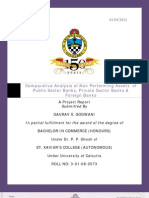Objectives of The Price Policy
Objectives of The Price Policy
Uploaded by
Prasanna HegdeCopyright:
Available Formats
Objectives of The Price Policy
Objectives of The Price Policy
Uploaded by
Prasanna HegdeOriginal Description:
Original Title
Copyright
Available Formats
Share this document
Did you find this document useful?
Is this content inappropriate?
Copyright:
Available Formats
Objectives of The Price Policy
Objectives of The Price Policy
Uploaded by
Prasanna HegdeCopyright:
Available Formats
Objectives of the Price Policy The following objectives are to be considered while fixing the prices of the product.
1. Profit maximization in the short term The primary objective of the firm is to maximize its profits. Pricing policy as an instrument to achieve this objective should be formulated in such a way as to maximize the sales revenue and profit . Maximum profit refers to the highest possible of profit. In the short run, a firm not only should be able to recover its total costs, but also should get excess revenue over costs. This will build the morale of the firm and instill the spirit of confidence in its operations. It may follow skimming price policy, i.e., charging a very high price when the product is launched to cater to the needs of only a few sections of people. It may exploit wide opportunities in the beginning. But it may prove fatal in the long run. It may lose its customers and business in the market. Alternatively, it may adopt penetration pricing policy i.e., charging a relatively lower price in the latter stages in the long run so as to attract more customers and capture the market. 2. Profit optimization in the long run The traditional profit maximization hypothesis may not prove beneficial in the long run. With the sole motive of profit making a firm may resort to several kinds of unethical practices like charging exorbitant prices, follow Monopoly Trade Practices (MTP), Restrictive Trade Practices (RTP) and Unfair Trade Practices (UTP) etc. This may lead to opposition from the people. In order to over come these evils, a firm instead of profit maximization, aims at profit optimization. Optimum profit refers to the most ideal or desirable level of profit.Hence, earning the most reasonable or optimum profit has become a part and parcel of a sound pricing policy of a firm in recent years. 3. Price Stabilization Price stabilization over a period of time is another objective. The prices as far as possible should not fluctuate too often. Price instability creates uncertain atmosphere in business circles. Sales plan becomes difficult under such circumstances. Hence, price stability is one of the pre requisite conditions for steady and persistent growth of a firm. A stable price policy only can win the confidence of customers and may add to the good will of the concern. It builds up the reputation and image of the firm. 4. Facing competitive situation One of the objectives of the pricing policy is to face the competitive situations in the market. In many cases, this policy has been merely influenced by the market share psychology. Wherever companies are aware of specific competitive products, they try to match the prices of their products with those of their rivals to expand the volume of their business. Most of the firms are not merely interested in meeting competition but are keen to prevent it. Hence, a firm is always busy with its counter business strategy. 5. Maintenance of market share
Market share refers to the share of a firm's sales of a particular product in the total sales of all firms in the market. The economic strength and success of a firm is measured in terms of its market share. In a competitive world, each firm makes a successful attempt to expand its market share. If it is impossible, it has to maintain its existing market share. Any decline in market share is a symptom of the poor performance of a firm. Hence, the pricing policy has to assist a firm to maintain its market share at any cost. 6. Capturing the Market Another objective in recent years is to capture the market, dominate the market, command and control the market in the long run. In order to achieve this goal, sometimes the firm fixes a lower price for its product and at other times even it may sell at a loss in the short term. It may prove beneficial in the long run. Such a pricing is generally followed in price sensitive markets. 7. Entry into new markets. Apart from growth, market share expansion, diversification in its activities a firm makes a special attempt to enter into new markets. Entry into new markets speaks about the successful story of the firm. Consequently, it has to bear the pioneering and subsequent risks and uncertainties. The price set by a firm has to be so attractive that the buyers in other markets have to switch on to the products of the candidate firm. 8. Deeper penetration of the market The pricing policy has to be designed in such a manner that a firm can make inroads into the market with minimum difficulties. Deeper penetration is the first step in the direction of capturing and dominating the market in the latter stages. 9. Achieving a target return A predetermined target return on capital investment and sales turnover is another long run pricing objective of a firm. The targets are set according to the position of individual firm. Hence, prices of the products are so calculated as to earn the target return on cost of production, sales and capital investment. Different target returns may be fixed for different products or brands or markets but such returns should be related to a single overall rate of return target. 10. Target profit on the entire product line irrespective of profit level of individual products. The price set by a firm should increase the sale of all the products rather than yield a profit on one product only. A rational pricing policy should always keep in view the entire product line and maximum total sales revenue from the sale of all products. A product line may be defined as a group of products which have similar physical features and perform generally similar functions. In a product line, a few products are regarded as less profit earning products and others are considered as more profit earning. Hence, a proper balance in pricing is required. 11. Long run welfare of the firm
A firm has multiple objectives. They are laid down on the basis of past experience and future expectations. Simultaneous achievement of all objectives are necessary for the over all growth of a firm. Objective of the pricing policy has to be designed in such a way as to fulfill the long run interests of the firm keeping internal conditions and external environment in mind. 12.Ability to pay Pricing decisions are sometimes taken on the basis of the ability to pay of the customers, i.e., higher price can be charged to those who can afford to pay. Such a policy is generally followed by those people who supply different types of services to their customers. 13. Ethical Pricing Basically, pricing policy should be based on certain ethical principles. Business without ethics is a sin. While setting the prices, some moral standards are to be followed. Although profit is one of the most important objectives, a firm cannot earn it in a moral vacuum. Instead of squeezing customer, a firm has to charge moderate prices for its products. The pricing policy has to secure reasonable amount of profits to a firm to preserve the interests of the community and promote its welfare.
You might also like
- BLR Form No. 4-16, With ChecklistDocument2 pagesBLR Form No. 4-16, With ChecklistLene Bao-anan100% (7)
- ANA Code of EthicsDocument2 pagesANA Code of EthicsPhil SimonNo ratings yet
- Teaching Plan For CapDocument4 pagesTeaching Plan For CapLorieAnnBringas50% (4)
- Marketing Management 510055252Document10 pagesMarketing Management 510055252Kota Mani KantaNo ratings yet
- Theories of ProfitDocument6 pagesTheories of Profitvinati100% (1)
- Working Capital Management: A Case Study of OCM: Mr. Rohit KandaDocument12 pagesWorking Capital Management: A Case Study of OCM: Mr. Rohit KandaManpreet Kaur VirkNo ratings yet
- Bell Hooks - Living by A Love Ethic - Ch. 6Document17 pagesBell Hooks - Living by A Love Ethic - Ch. 6Dakuro A EthanNo ratings yet
- Durable General Power of Attorney (New York)Document2 pagesDurable General Power of Attorney (New York)Legal Forms100% (1)
- The Nature of Strategy EvaluationDocument9 pagesThe Nature of Strategy Evaluationyosef bekeleNo ratings yet
- Cost Audit FinalDocument20 pagesCost Audit FinalAkash BhavsarNo ratings yet
- Unit 1 - HRMDocument43 pagesUnit 1 - HRMbalajiNo ratings yet
- MBA NotesDocument13 pagesMBA NotesRanjeet Verma LucknowNo ratings yet
- Unit 3 International BusinessDocument25 pagesUnit 3 International BusinessMrudul MuraliNo ratings yet
- Capital StructureDocument4 pagesCapital StructureNaveen GurnaniNo ratings yet
- Taylor's Scientific Management Concept and His ContributionsDocument2 pagesTaylor's Scientific Management Concept and His ContributionsjibharatNo ratings yet
- Indian Marketing EnvironmentDocument9 pagesIndian Marketing EnvironmentRaju VeluruNo ratings yet
- Salesmanship: Unit - 3Document82 pagesSalesmanship: Unit - 3yatin rajputNo ratings yet
- BPSM NotesDocument15 pagesBPSM Notesdeepikab_21No ratings yet
- Incentives and Fringe BenefitsDocument4 pagesIncentives and Fringe BenefitsPankaj2cNo ratings yet
- MBA - III SemesterDocument44 pagesMBA - III SemesterPrakash VadavadagiNo ratings yet
- Industrial Concentration: Meaning and Its Measurement Economics BY Prof.B.Sudhakar ReddyDocument40 pagesIndustrial Concentration: Meaning and Its Measurement Economics BY Prof.B.Sudhakar ReddyProf B Sudhakar Reddy100% (1)
- Electric Scooter Vs Petrol Scooter (Final)Document23 pagesElectric Scooter Vs Petrol Scooter (Final)Dynamic GamingNo ratings yet
- ME - Objectives of Business Firms - 10Document29 pagesME - Objectives of Business Firms - 10semerederibe100% (2)
- Pom - Inventory ManagementDocument5 pagesPom - Inventory ManagementMURALI KRISHNA VELAVETI Dr.No ratings yet
- Ii B.com - 3 Sem-Cost-TheoryDocument19 pagesIi B.com - 3 Sem-Cost-TheoryAR Ananth Rohith BhatNo ratings yet
- Foreign Exchange in PDFDocument62 pagesForeign Exchange in PDFArun Kumar100% (2)
- Comparative Study in Equity Schemes of Various Companies Mutual FundDocument71 pagesComparative Study in Equity Schemes of Various Companies Mutual FundWebsoft Tech-HydNo ratings yet
- Module 05Document11 pagesModule 05Deepika SoniNo ratings yet
- BBA Marketing Case Analysis EhsanulHudaChowdhuryDocument5 pagesBBA Marketing Case Analysis EhsanulHudaChowdhuryRubaiat HishamNo ratings yet
- Security Analysis and Portfolio Management (SAPM) E-Lecture Notes (For MBA) IMS, MGKVP, Session 2020Document17 pagesSecurity Analysis and Portfolio Management (SAPM) E-Lecture Notes (For MBA) IMS, MGKVP, Session 2020Sukanya ShridharNo ratings yet
- Synopsis of PraveenDocument8 pagesSynopsis of PraveenNageshwar SinghNo ratings yet
- Theories of Entrepreneurship and Entrepreneurial MotivationDocument39 pagesTheories of Entrepreneurship and Entrepreneurial MotivationLIBIN JOSENo ratings yet
- Marketing Information SystemDocument3 pagesMarketing Information SystemBint e AyshaNo ratings yet
- Financial Management 5th Sem. NotesDocument4 pagesFinancial Management 5th Sem. NotesAmit Mondal0% (1)
- The Objective of Selection Decision Is ToDocument20 pagesThe Objective of Selection Decision Is Toskumar002100% (5)
- Theories of Mergers and Tender OffersDocument13 pagesTheories of Mergers and Tender OffersSonal Bhakhar50% (2)
- Differences Between Piece Rate System and Time Rate System of Wage PaymentDocument1 pageDifferences Between Piece Rate System and Time Rate System of Wage PaymentSugato C MukherjiNo ratings yet
- Eabd Unit 1 & 2 UpdatedDocument130 pagesEabd Unit 1 & 2 UpdatedsuvarediveshNo ratings yet
- A. Life Insurance Contractual ProvisionsDocument23 pagesA. Life Insurance Contractual ProvisionsMadhu dollyNo ratings yet
- Fundamental Analysis in SAPMDocument6 pagesFundamental Analysis in SAPMRoshan VargheseNo ratings yet
- Question: What Are The Functional Areas Of: Financial Management?Document3 pagesQuestion: What Are The Functional Areas Of: Financial Management?Madhubala SinghNo ratings yet
- Dividend and Determinants of Dividend PolicyDocument3 pagesDividend and Determinants of Dividend PolicyAmit PandeyNo ratings yet
- Chapter 3 - Incorporating Investor Behavior PDFDocument9 pagesChapter 3 - Incorporating Investor Behavior PDFassem mohamedNo ratings yet
- Motivation Strategies in Current ScenarioDocument3 pagesMotivation Strategies in Current Scenariokeerthika12311100% (1)
- Conceptual Framework 1Document10 pagesConceptual Framework 1sampad DasNo ratings yet
- Unit IV(Kmbn 302)Document11 pagesUnit IV(Kmbn 302)chandniverma.0623No ratings yet
- Chapter 1 PDFDocument20 pagesChapter 1 PDFANILNo ratings yet
- Anand Engineering College, Agra Bba Program Business EthicsDocument8 pagesAnand Engineering College, Agra Bba Program Business EthicsakshayaecNo ratings yet
- PA at OutlookDocument7 pagesPA at Outlookeepsitha bandayNo ratings yet
- Contemporary IssuesDocument15 pagesContemporary IssuesDrPriyanka Prashant Pawshe100% (1)
- Legal Aspects of Business Master NotesDocument44 pagesLegal Aspects of Business Master NotesSenthil Kumar GanesanNo ratings yet
- Behavioural Issues in Strategy ImplementationDocument2 pagesBehavioural Issues in Strategy ImplementationAnju Gaurav DrallNo ratings yet
- Synergy & Dysergy by IPSDocument23 pagesSynergy & Dysergy by IPSips478883% (6)
- Business EnvironmentDocument17 pagesBusiness EnvironmentDrShailesh Singh Thakur100% (1)
- Financial MGMT MBA 2nd SemDocument188 pagesFinancial MGMT MBA 2nd Semnimala maniNo ratings yet
- Resistance To ChangeDocument7 pagesResistance To ChangeNitesh Goud100% (1)
- Structure of Mutual Funds in IndiaDocument7 pagesStructure of Mutual Funds in IndiashubhamNo ratings yet
- Inflation and UnemploymentDocument18 pagesInflation and UnemploymentDayaNo ratings yet
- Alternative Theories of The FirmDocument3 pagesAlternative Theories of The FirmAliciaNo ratings yet
- 1 Questionnaire FinalDocument105 pages1 Questionnaire FinalKashif KhanNo ratings yet
- International Liquidity and Reserve ProblemsDocument34 pagesInternational Liquidity and Reserve ProblemsUthama Veeran50% (2)
- Recruitment Process Outsourcing A Complete Guide - 2020 EditionFrom EverandRecruitment Process Outsourcing A Complete Guide - 2020 EditionNo ratings yet
- Value Chain Management Capability A Complete Guide - 2020 EditionFrom EverandValue Chain Management Capability A Complete Guide - 2020 EditionNo ratings yet
- Production And Operations Management A Complete Guide - 2020 EditionFrom EverandProduction And Operations Management A Complete Guide - 2020 EditionNo ratings yet
- Vedic MathsDocument220 pagesVedic Mathstargettutorials5740100% (7)
- Comparative Analysis of Non Performing Assets of Public Sector, Private Sector & Foreign BanksDocument73 pagesComparative Analysis of Non Performing Assets of Public Sector, Private Sector & Foreign BanksGaurav S. Godwani0% (1)
- Case StudyDocument24 pagesCase StudyPrasanna HegdeNo ratings yet
- M.S.Ramaiah Institute of Technology Department of Management StudiesDocument5 pagesM.S.Ramaiah Institute of Technology Department of Management StudiesPrasanna HegdeNo ratings yet
- RfidDocument11 pagesRfidVila HeffanyNo ratings yet
- ThailandDocument30 pagesThailandIskandar MustofaNo ratings yet
- Motivation Style QuestionnaireDocument2 pagesMotivation Style Questionnaireapi-242277375No ratings yet
- Samuel R. Dickey v. Cbs Inc., 583 F.2d 1221, 3rd Cir. (1978)Document13 pagesSamuel R. Dickey v. Cbs Inc., 583 F.2d 1221, 3rd Cir. (1978)Scribd Government DocsNo ratings yet
- Lesson 1-QuizDocument5 pagesLesson 1-QuizKimberly Ann Castro VitugNo ratings yet
- Full Download Forgotten Justice The Forms of Justice in the History of Legal and Political Theory 1st Edition Allan Beever PDF DOCXDocument67 pagesFull Download Forgotten Justice The Forms of Justice in the History of Legal and Political Theory 1st Edition Allan Beever PDF DOCXrizikclipphv100% (4)
- The Teaching Profession Quiz 1Document1 pageThe Teaching Profession Quiz 1Jai JosonNo ratings yet
- Contract of Sale: Consensual Bilateral Onerous Commutative Nominate PrincipalDocument12 pagesContract of Sale: Consensual Bilateral Onerous Commutative Nominate PrincipalStephanie Queen OcampoNo ratings yet
- Living Will DeclarationDocument6 pagesLiving Will Declarationamazing_pinoyNo ratings yet
- Sem 2Document4 pagesSem 2Batang Yagit KrisTininayNo ratings yet
- Manual - Dazel Attribute ListDocument330 pagesManual - Dazel Attribute ListUngku Saiful Ungku YusofNo ratings yet
- Vienna Convention On Diplomatic RelationsDocument27 pagesVienna Convention On Diplomatic RelationsClaireNo ratings yet
- Overtime Computation FormulaDocument2 pagesOvertime Computation FormulaCharie GNo ratings yet
- EthicsDocument3 pagesEthicsmaryeonee12No ratings yet
- Mecenas vs. CADocument2 pagesMecenas vs. CAFelyDiloyNo ratings yet
- Unemployment Insurance A Claimant HandbookDocument84 pagesUnemployment Insurance A Claimant HandbookFloydNo ratings yet
- Executive Order No. 385, 1996Document3 pagesExecutive Order No. 385, 1996VERA FilesNo ratings yet
- Part - VI: Person Who Fixes With AffectionDocument3 pagesPart - VI: Person Who Fixes With AffectionjyotisatpathyNo ratings yet
- Eg2401 THL Tutorial 2Document2 pagesEg2401 THL Tutorial 2Tey Wee WeeNo ratings yet
- The Development of Social Welfare in The PhilippinesDocument13 pagesThe Development of Social Welfare in The Philippinespinakamamahal95% (20)
- Mystics of The Renaissance and Their Relation To Modern Thought - Rudolf SteinerDocument156 pagesMystics of The Renaissance and Their Relation To Modern Thought - Rudolf SteinerScriptoria Books50% (2)
- Lecture 2Document32 pagesLecture 2Maham AhsanNo ratings yet
- Mystery Method - The Easiest Way To Pick-UpDocument3 pagesMystery Method - The Easiest Way To Pick-UpMike LyonsNo ratings yet
- Status of The Ulema Adaab of IkhtilaafDocument21 pagesStatus of The Ulema Adaab of IkhtilaafMuhammad Sa'id HunafaNo ratings yet
- Ecocritical Readings of Ted Hughes, Seamus Heaney and Dylan ThomasDocument31 pagesEcocritical Readings of Ted Hughes, Seamus Heaney and Dylan ThomasYogesh AnvekarNo ratings yet
- CHAPTER 5 HandoutDocument4 pagesCHAPTER 5 Handout24lnt0404msNo ratings yet






























































































